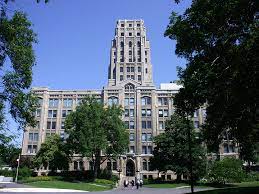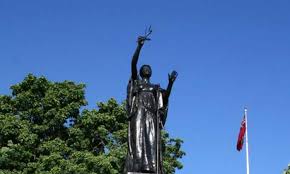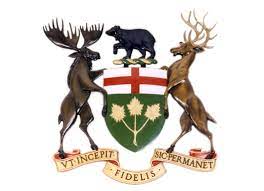A very entrepreneurial and public-spirited former student of mine, Alex Rascanu, has formed a Meetup group called ExperienceTO, and he leads walking tours of Toronto sites. I join him as a commentator for sites for which I have expertise. Recently he led a tour of Queen’s Park, focusing on its many statues. And it was a perfect day – sunny and warm for late October.
I often improvise, speaking about things I notice or responding to questions. Among the 65 people on the tour, most of them local, there was an American woman who asked a lot of good questions, so I directed my comments to things a non-Canadian wouldn’t know but would find interesting.

The Whitney Block: Hiding in Plain Sight
We started the tour at the Whitney Block, a modern Gothic art deco building east of the Legislature, across Queen’s Park Circle. When in opened in the 1920s, it housed the entire Ontario Public Service (OPS). Of course, the OPS has grown since then, and its main home is a set of four international style buildings constructed in the 1960s, known as the Macdonald Block Complex, just east of the Whitney Block. (The buildings are now undergoing a major renovation, which has left the Ontario Public Service dispersed throughout downtown Toronto.) The Whitney Block continues to play a vital role and it houses both the Premier’s Office and Cabinet Office but, standing between Queen’s Park and the Macdonald Block Complex, it is overlooked. The Whitney Block also has a seven-storey tower that no longer meets building code and has been abandoned for some sixty years. We started at the base of the Whitney Block tower and then moved to several other locations around Queen’s Park from which, when I point it out, the tower dominates the view.

In the Line of Duty
Just south of the Whitney Block is a monument dedicated in 2000 to police officers who have been killed in the line of duty. The monument lists the name, unit, and date of each tragedy. It has a little open space, but it is depressing to think that it will run out of space soon.
Across Queen’s Park Circle is a much older monument, unveiled in 1895 in memory of the soldiers and volunteers who died in the 1885 North-West Rebellion. A glance is all that is needed to realize that the names are those of settlers, not of the Metis and indigenous resistance led by Louis Riel. The Metis Nation of Ontario have held their observance of Louis Riel Day at the Northwest Rebellion Monument since 2011 but, with good reason, have also considered moving it to another location. The monument was the first public commission of then 19-year-old Walter Allward, whose most famous work is the Vimy Memorial.
Contestable History
Not far from the Northwest Rebellion Memorial, in front of the Legislature, is a statue of James P. Whitney, who was premier of Ontario from 1905 to 1914. The Whitney Government established Ontario Hydro, recognizing the rationale for putting a new technology that is a natural monopoly under public ownership. The Whitney Government also enacted the hugely controversial Regulation 17, which prohibited the teaching of French beyond the first three years of school.
At the southern end of Queen’s Park, the 1894 statue of Sir John A. Macdonald, Canada’s first prime minister, is now encased in plywood, because of attempts to cancel it to protest his role in creating the residential school system. Beside the plywood wall on the north side, there is now a collection of children’s shoes.

The Retro Flag and Motto
In front of the legislature are two flagpoles. Our American visitor quickly recognized the Canadian flag but asked us to identify the other one. I told her the story of the bitter national debate in the early Sixties about the introduction of the maple leaf flag to replace the Canadian ensign. The Robarts Government, responding to the sentiment of Ontario’s then-majority of British origin, simultaneously introduced an Ontario flag based on the ensign, but with a stylized Ontario coat of arms replacing the Canadian coat of arms. She was surprised that the Canadian flag is of such recent origin, and she also concluded that the Ontario flag is a consolation prize for those who saw themselves as losers in the debate.

At the back of the Legislature, we saw Ontario’s coat of arms and motto, both carved in stone. The motto “ut incepit fidelis, sic permanent” is translated as “loyal she began, loyal she remains,” but what does it signify? I explained that it refers to Ontario’s founding settlers, the United Empire Loyalists, who fled the US or were pushed out after the American Revolution. The coat of arms contains local symbols – the maple leaf, beaver, moose, and deer – but also a classic English symbol – the cross of St. George.
A Settler-Colonialist Story
The unexpected conclusion I drew from the tour is that the statuary and symbolism depict a settler-colonial history, with a strong focus on the links between Canada and the British Crown. I should also mention the statues of Queen Victoria, King Edward VII, and now Queen Elizabeth II. The history is contestable in its inclusion of people who suppressed indigenous Canadians (Macdonald and the RCMP) and francophones (Whitney).
There is a strong case for presenting Ontario’s heritage and history in a way that includes indigenous stories as well as its current diversity. (There is a recent monument representing Ontario’s francophone community, in effect a corrective to the Whitney statue.) Flags, statues, and mottoes aren’t easy to change; some are literally carved in stone. Given the demographics of Ford Nation, it is a certainty that the Ford Government isn’t interested. But, in my view, the necessity of telling different stories remains.

Leave a Reply